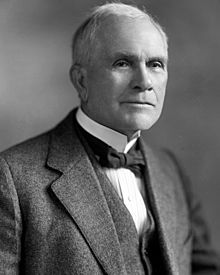B. B. Comer | |
|---|---|
 Official portrait, 1920 | |
| United States Senator from Alabama | |
| In office March 5, 1920 – November 2, 1920 | |
| Appointed by | Thomas Kilby |
| Lieutenant | Henry B. Gray |
| Preceded by | John H. Bankhead |
| Succeeded by | J. Thomas Heflin |
| 33rd Governor of Alabama | |
| In office January 14, 1907 – January 17, 1911 | |
| Preceded by | William D. Jelks |
| Succeeded by | Emmet O'Neal |
| Personal details | |
| Born | Braxton Bragg Comer November 7, 1848 Spring Hill, Alabama |
| Died | August 15, 1927 (aged 78) Birmingham, Alabama |
| Political party | Democratic |
| Spouse | Eva Jane |
| Children | Sally Bailey Comer John Fletcher Comer James McDonald Comer Eva Mignon Comer Catherine Comer Braxton Bevelle Comer Eva Comer Braxton Bragg Comer Jr. Hugh M. Comer |
| Relatives | Hugh Comer (brother) J. W. Comer (brother) |
| Education | University of Alabama University of Georgia Emory and Henry College |
| Signature | |
Braxton Bragg Comer (November 7, 1848 – August 15, 1927) was an American politician who served as the 33rd governor of Alabama from 1907 to 1911, and a United States senator in 1920. As governor, he achieved railroad reform, lowering business rates in Alabama to make them more competitive with other states. He increased funding for the public school system, resulting in more rural schools and high schools in each county for white students and a rise in the state's literacy rate.
Comer was a planter and businessman before and after entering politics as a Democrat. He inherited the Comer family 30,000-acre (120 km2) plantation, which was devoted to corn and cotton production. He had an interest in the Comer mines near Birmingham known as the Eureka Mines. In 1897 he invested $10,000 with the Trainer family, who intended to develop textile mills in the state, and he was appointed president of Avondale Mills, which he developed in Birmingham, serving in that role until he died in 1927.